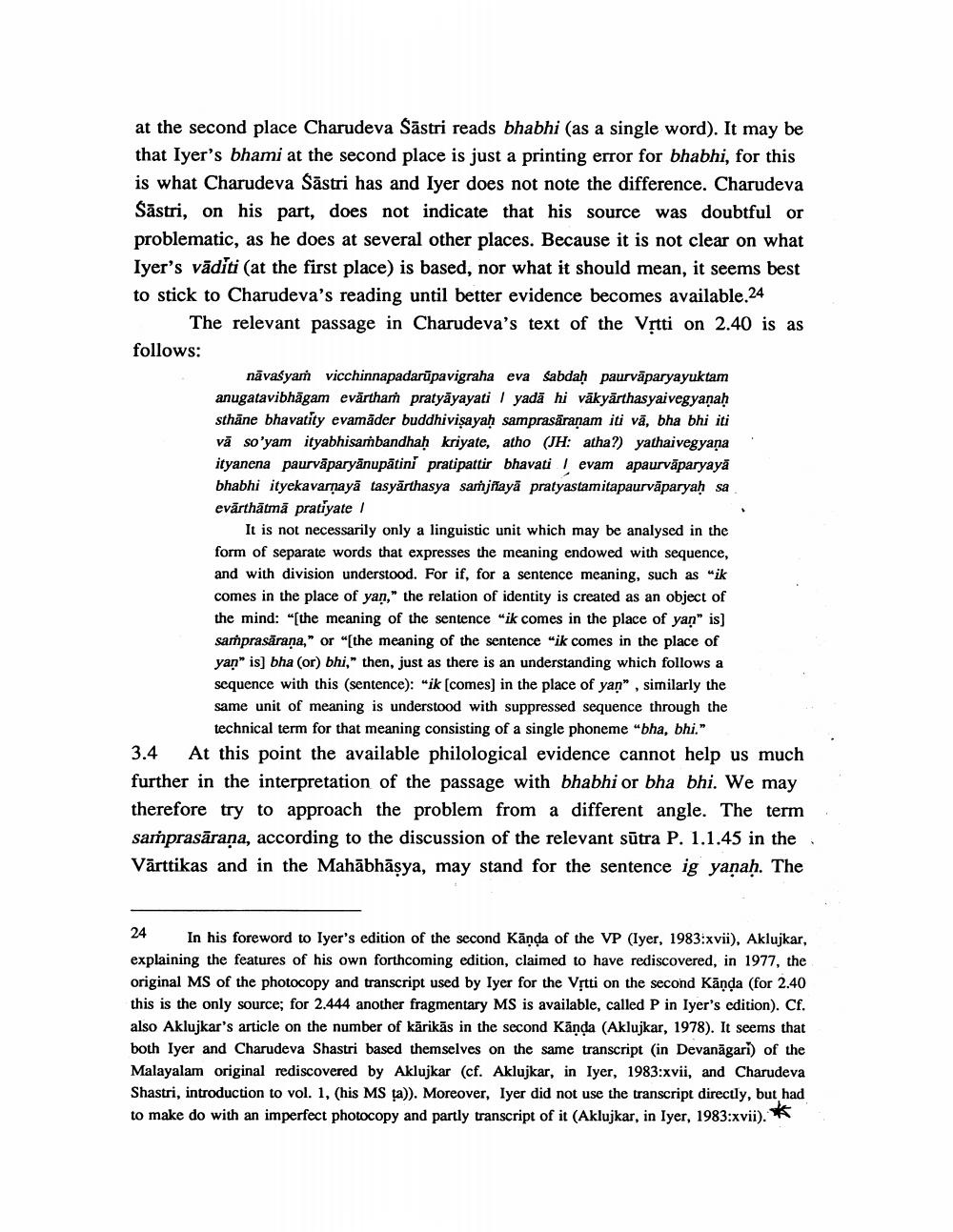________________
at the second place Charudeva Šāstri reads bhabhi (as a single word). It may be that Iyer's bhami at the second place is just a printing error for bhabhi, for this is what Charudeva Šāstri has and lyer does not note the difference. Charudeva Sāstri, on his part, does not indicate that his source was doubtful or problematic, as he does at several other places. Because it is not clear on what Iyer's vāditi (at the first place) is based, nor what it should mean, it seems best to stick to Charudeva's reading until better evidence becomes available 24
The relevant passage in Charudeva's text of the Vịtti on 2.40 is as follows:
nāvasyam vicchinnapadarūpavigraha eva sabdaḥ paurvāparyayuktam anugatavibhāgam evärthaí pratyāyayati 1 yadā hi vākyärthas yaivegyanah sthāne bhavatity evamăder buddhivisayaḥ samprasāranam iti vā, bha bhi iti vā so'yam ityabhisambandhah kriyate, atho (JH: atha?) yathaivegyana ityanena paurvāparyānupātini pratipattir bhavatievam apaurvāparyayā bhabhi ityekavarnayā tasyārthasya saṁjsayā pratyastamitapaurvāparyah sa evārthātmā pratiyate
It is not necessarily only a linguistic unit which may be analysed in the form of separate words that expresses the meaning endowed with sequence, and with division understood. For if, for a sentence meaning, such as "ik comes in the place of yan," the relation of identity is created as an object of the mind: "[the meaning of the sentence "ik comes in the place of yan" is) samprasarana," or "[the meaning of the sentence "ik comes in the place of yan" is) bha (or) bhi," then, just as there is an understanding which follows a sequence with this sentence): "ik (comes) in the place of yan" , similarly the same unit of meaning is understood with suppressed sequence through the
technical term for that meaning consisting of a single phoneme "bha, bhi." 3.4 At this point the available philological evidence cannot help us much further in the interpretation of the passage with bhabhi or bha bhi. We may therefore try to approach the problem from a different angle. The term samprasārana, according to the discussion of the relevant sūtra P. 1.1.45 in the Vārttikas and in the Mahābhāsya, may stand for the sentence ig yanah. The
24 In his foreword to Iyer's edition of the second Kānda of the VP (Iyer, 1983:xvii), Aklujkar, explaining the features of his own forthcoming edition, claimed to have rediscovered, in 1977, the original MS of the photocopy and transcript used by Iyer for the Vrtti on the second Kānda (for 2.40 this is the only source; for 2.444 another fragmentary MS is available, called P in Iyer's cdition). Cf. also Aklujkar's article on the number of kārikās in the second Kända (Aklujkar, 1978). It seems that both Iyer and Charudeva Shastri based themselves on the same transcript in Devanāgari) of the Malayalam original rediscovered by Aklujkar (cf. Aklujkar, in Iyer, 1983:xvii, and Charudeva Shastri, introduction to vol. 1, (his MS ta)). Moreover, lyer did not use the transcript directly, but had to make do with an imperfect photocopy and partly transcript of it (Aklujkar, in Iyer, 1983:xvii).*




